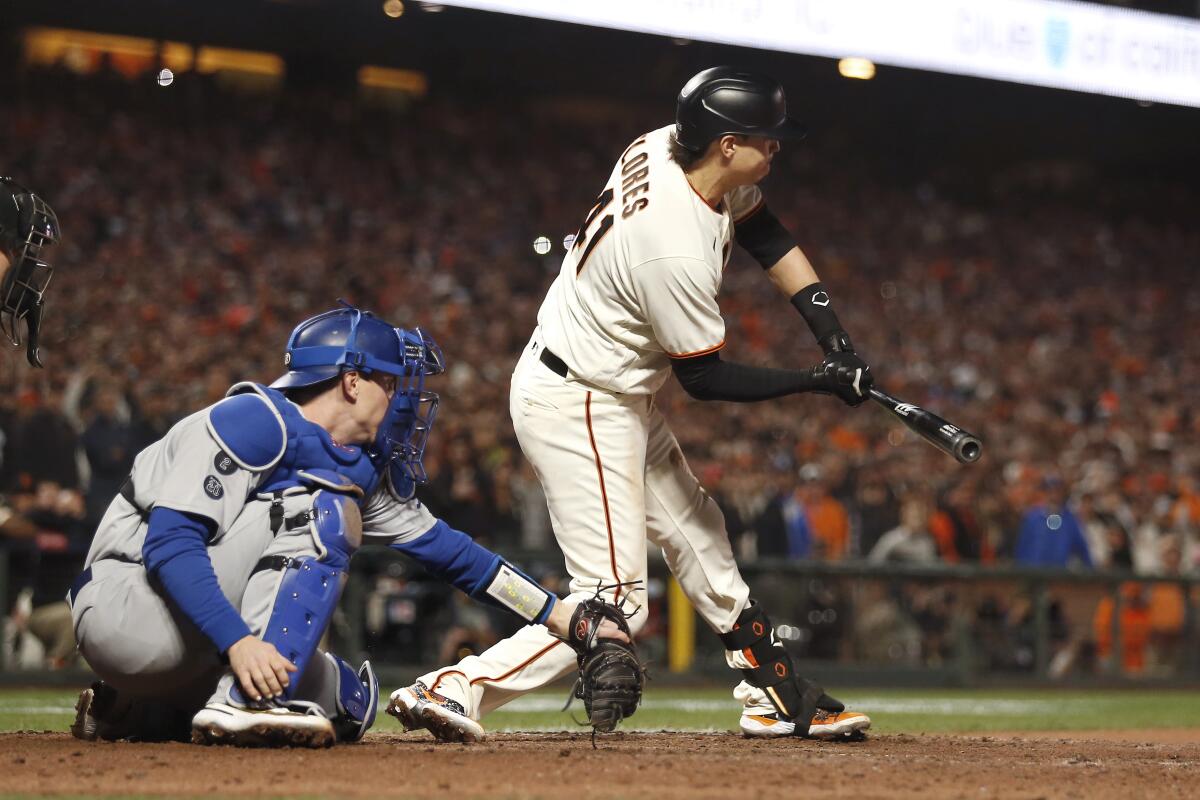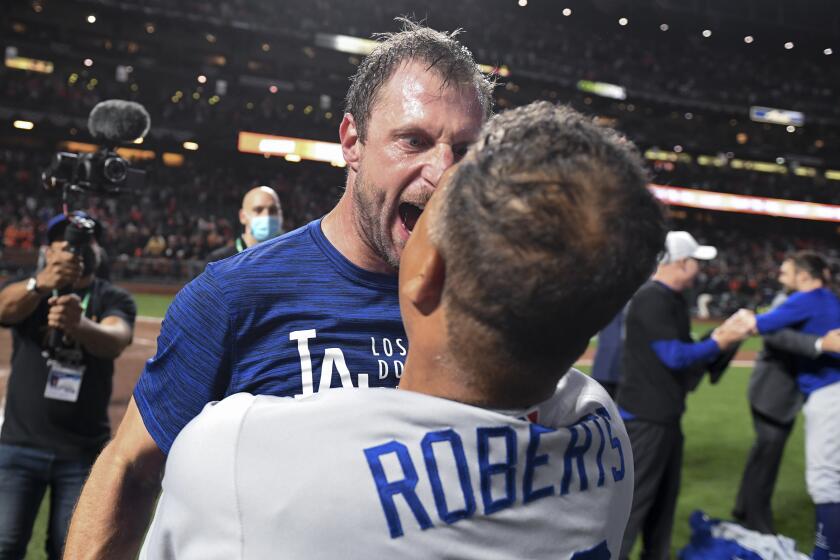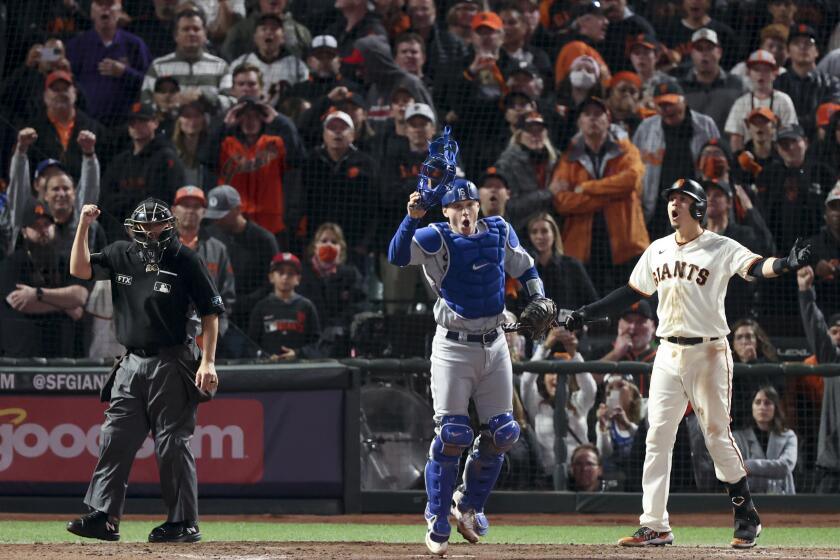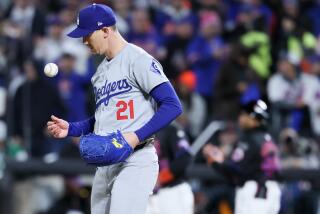Explaining the check-swing blown call that felled the Giants and delighted the Dodgers

- Share via
One of the greatest seasons in major league history ends on a blown call. Not on a controversial call. Not on a play governed by an obscure rule. A blown call that will be revisited and discussed for years.
The San Francisco Giants’ historic run was extinguished Thursday when first base umpire Gabe Morales ruled Wilmer Flores swung at an 0-2 pitch from the Dodgers’ Max Scherzer with two outs in the ninth inning of the deciding Game 5 of the NLDS.
“That’s going to be the thing that is talked about quite a bit and I understand why,” Giants manager Gabe Kapler said.
A check swing is unlike any other call. Whether or not a batter has offered at a pitch is ill-defined in the rule book, is often deferred from one umpire to another, and the umpire burdened with making the decision doesn’t have a favorable view.
No one, however, except the man charged with making the call believed Flores swung. Outrage ensued, as did pertinent questions that don’t have easy answers.
What’s the definition of a swing?
In the “Definition of Terms” section of the 2021 edition of the Official Baseball Rules, 83 words or phrases are explained. In just the “S” section, definitions are provided for the set position, a squeeze play, the strike zone and a suspended game. A swing is not included.
Umpires treat a check-swing strike call a lot like what U.S. Supreme Court Justice Potter Stewart famously stated in 1964 describing his definition for obscenity: “You know it when you see it.”
In perhaps the greatest chapter in the history of the Dodgers-Giants rivalry, the Dodgers prevail, winning an intense five-game playoff series.
Ted Barrett, the umpire crew chief in the NLDS, tried to explain a swing after Game 5: “By the rule book, it just says, did he offer at the pitch? So, there’s some ambiguity there, but we do our best to try to be consistent, so players know what’s a swing and what’s not.”
A strike is described in the rule book as “a legal pitch when so called by the umpire, which (a) Is struck at by the batter and is missed.”
No help there either.
Whether a bat crosses the front edge of home plate or a batter snaps his wrist during a check swing are myths in the category of “tie goes to the runner.”
Why is the plate umpire able to appeal a check-swing call?
A check swing is one of only a small handful of plays where it’s appropriate for a team to ask the umpire who made a call to ask for help from a partner. The reasoning is that the base umpire might have a better view of the check swing than the plate umpire.
When the plate umpire asks for help, he goes to the first-base umpire when the batter is right-handed and to the third-base umpire when the batter is left-handed.
Rule 8.02 addresses appeals of an umpire’s decisions and rule 8.02(c) specifically addresses appealing check swings.
“A manager or catcher may request the plate umpire to ask a base umpire for help on a checked swing when the plate umpire calls the pitch a ball, but not when the pitch is called a strike. Should the base umpire call the pitch a strike, the strike call shall prevail.”
Umpires are trained not to call a strike if they are unsure whether a batter swung at a pitch out of the strike zone. That way they can ask for help if the catcher or manager appeals.
There’s a history this season of bad checked swing calls for the Dodgers and Giants.
Why isn’t a check swing reviewable?
Important question without an acceptable answer. MLB is already pushing to shorten the time of games and reviews of check-swing calls would work against that objective.
Balls and strikes are not reviewable — arguing them, in fact, is grounds for ejection. It’s been convenient enough for MLB to define checked swings as ball and strike calls. Furthermore, one umpire has already appealed to another in an attempt to get the call correct. Allowing replay would essentially be an appeal of an appeal.
Overall, each manager is allotted one challenge per game, with additional challenges granted if the previous one was successful. From the eighth inning on, the umpire crew chief may initiate his own replay review. But for now, that doesn’t include a check swing.
Could the NLDS Game 5 blown call trigger a rules change?
A blown pass interference call late in the 2019 NFC championship game that enabled the Rams to advance to the Super Bowl prompted the NFL to allow replay on pass interference calls the next fall.
A year later, NFL vice president Troy Vincent said the pass interference replay system “failed miserably” and it was rescinded.
Interviewed after Game 5, Morales seemed to hint that replay on checked swings could be useful.
“Check swings are one of the hardest calls we have,” he said. “I don’t have the benefit of multiple camera angles when I’m watching it live. When it happened live, I thought he went, so that’s why I called it a swing.”
MLB can implement changes in replay without the consent of the players’ union. For a start, maybe the big leagues could adopt a rule used in the Little League World Series: The final play of all games are automatically reviewed.
Times assistant sports editor Steve Henson is a baseball umpire with the Channel Coast Officials Assn., which supplies high school officials in all sports from Calabasas to Santa Barbara.
More to Read
Are you a true-blue fan?
Get our Dodgers Dugout newsletter for insights, news and much more.
You may occasionally receive promotional content from the Los Angeles Times.










